By Donna Insco
A dairy goat buck is literally half of your herd, and your choice of males can affect your herd for ten years or more. A doe can have a productive life of eight years or so, and can produce perhaps fourteen kids over her entire lifetime. But a buck used for just three years in a small herd can be responsible for dozens of offspring. So it is wise to use the best male that you can afford.
Paying to use someone else’s buck may be an option if you live in an area with many goat owners. However, finding a quality buck for hire of the same breed as your does may be difficult. Leasing a buck isn’t cheap, either—expect to pay well for stud service. In addition, you may be required to show health papers and vaccination records signed by a veterinarian to prove your does are healthy. Plus, when one of your does comes into heat, you must drop everything and immediately take her to the buck’s farm for breeding. Few goat owners can plan their autumn around their herd’s estrus cycle. Add in the cost of gas and the necessity of finding a good buck for hire within a reasonable driving distance. For these reasons, it makes financial sense to buy a buck of your own anytime a herd consists of more than three does.
Commercial goat dairies and show herds are often good places to shop for quality males. Dairies and show herds focus on production and conformation, so animals will likely be carrying superior genetics. In addition, commercial dairies and show herds often practice prevention measures for communicable diseases such as Johne’s disease and caprine arthritis encephalitis (CAE). So buyers can confidently expect to purchase healthy males.
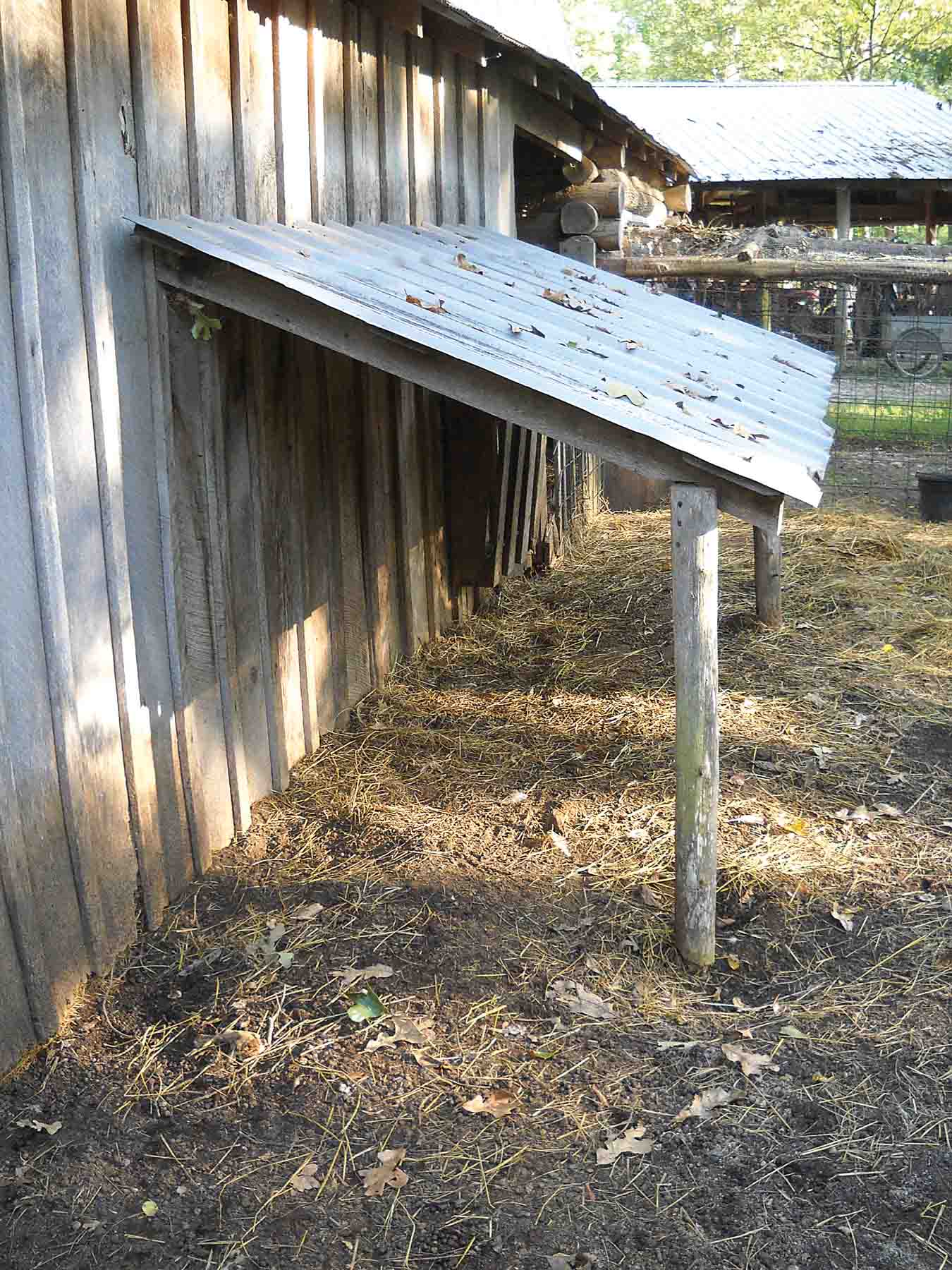
Lean-to buck shelter.
Buying your buck
Some owners will use a buck for only three to four years before replacing him with one unrelated to their herd. So buying a mature buck of good breeding may be an option for you. However, bucks tend to live shorter lives than does due to the rigors of breeding season, so any buck for sale older than five years might be a risky purchase.
Consider a mature buck’s track record before purchase. Ask to see his daughters to ensure he is passing desirable traits to his female offspring, such as capacious udders with good attachments and large well-formed teats. Ask about the incidence of mastitis, birthing problems, or other health issues in his female relatives. Inquire about his own health history, including when he last received treatment for worms and which anthelmintic was used. Research suggests that testicular size is an indicator of fertility in male livestock, so make sure he has two large symmetrical testicles. Also, overall conformation and adherence to breed type should be assessed when considering purchasing an adult buck.
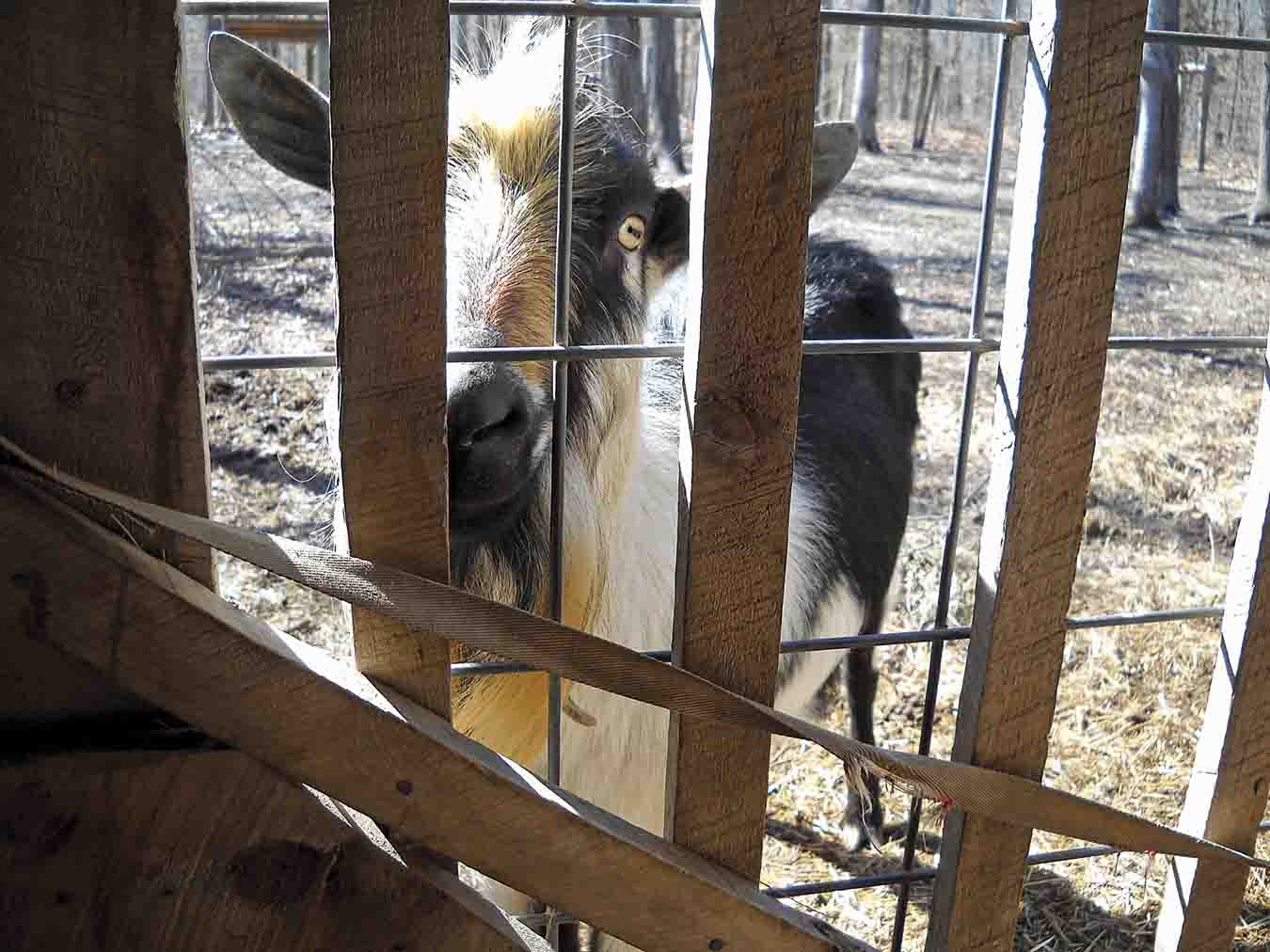
An escape artist requires a pen that resembles Fort Knox.
Remember, a mature buck comes with a “personality.” Before you buy him, ask the owner about his idiosyncrasies. It is better to find out beforehand that he excels at jailbreak instead of chasing him across the county the day after you bring him home. Discover his ease of handling by asking to see him led about and his feet handled. Most owners will welcome your interest and your polite questions. People who own high-powered bucks like to show them off and are proud of the improvements a buck has made to their herd.
Another option is to buy a young buckling and raise him to be herd sire. Goat dairies and show herds may list newborns for sale on their web sites in late winter. Very desirable bucklings from high producing does may sell fast. Some may have been sold before they were even born, so shop early. When buying a newborn, ask the owner to keep the youngster until he is two or three weeks old, even if it means paying extra. At this age he should be well started and sturdy. It’s a definite plus if someone at his birth farm teaches him to drink from a pail instead of a bottle.
Transporting
Riding in a moving vehicle is a stressful event in a goat’s life. For his safety and comfort, it’s best to use an enclosed trailer to transport a large buck to his new home. Simply tying him in the open bed of a truck is not a good idea. He may get chilled in cold weather, receive an eye injury from flying debris, or become frightened at the scenery speeding by and try to jump out.
A buck weighing less than 80 pounds can be transported in an extra-large pet carrier. Lay a thick layer of shredded paper in the bottom of the carrier to absorb urine and add a couple of inches of bedding. Young kids are easily chilled, so during cold weather the carrier should be transported in an enclosed vehicle. Do not attempt to transport a goat, even a very young one, loose in a car or on someone’s lap. The goat will end up driving, you may get in an accident, and your insurance company will not be amused. Frightened goat urine is pungent and persistent, so at the very least, the inside of your vehicle will look and smell disgusting for several weeks.
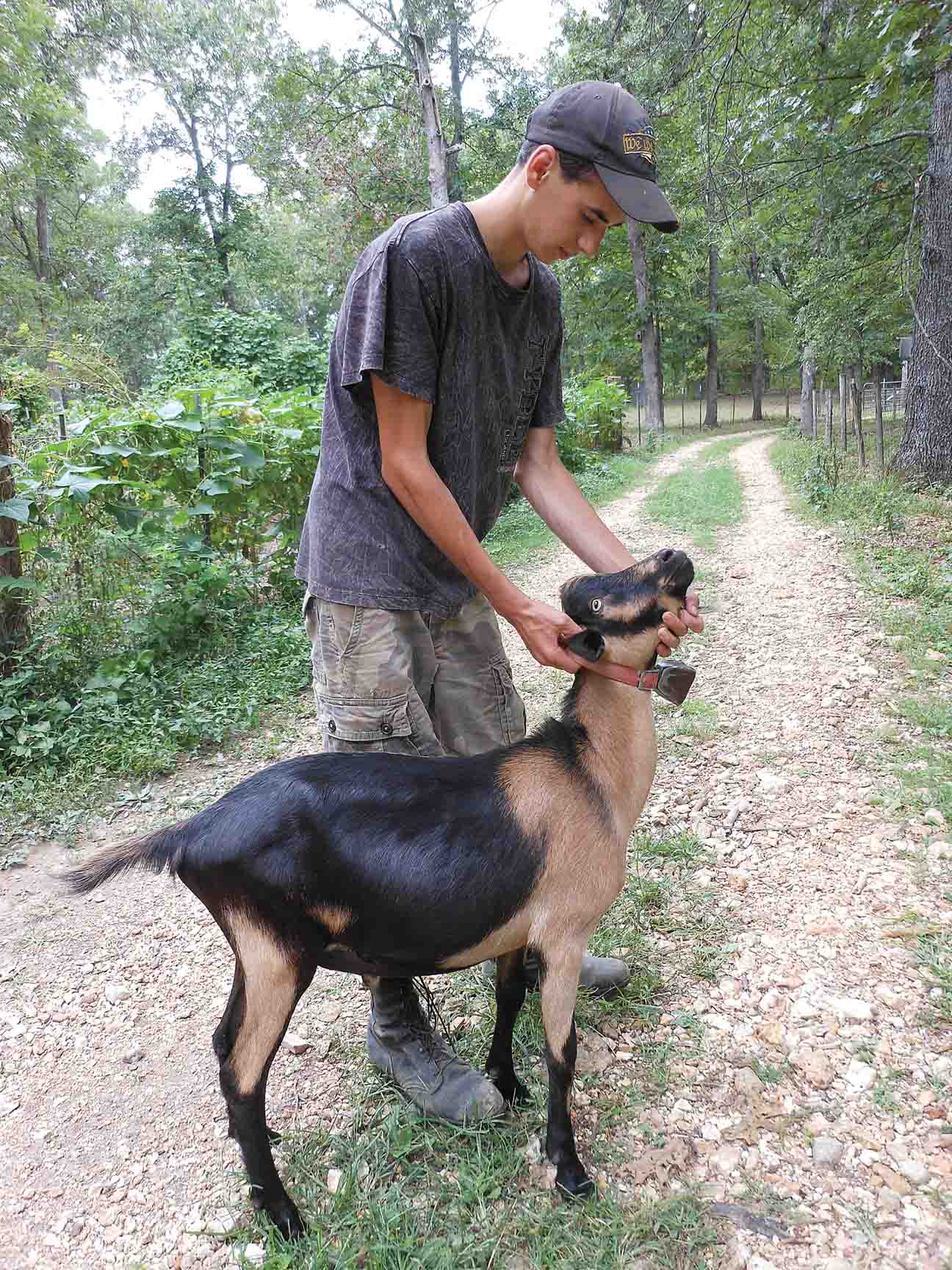
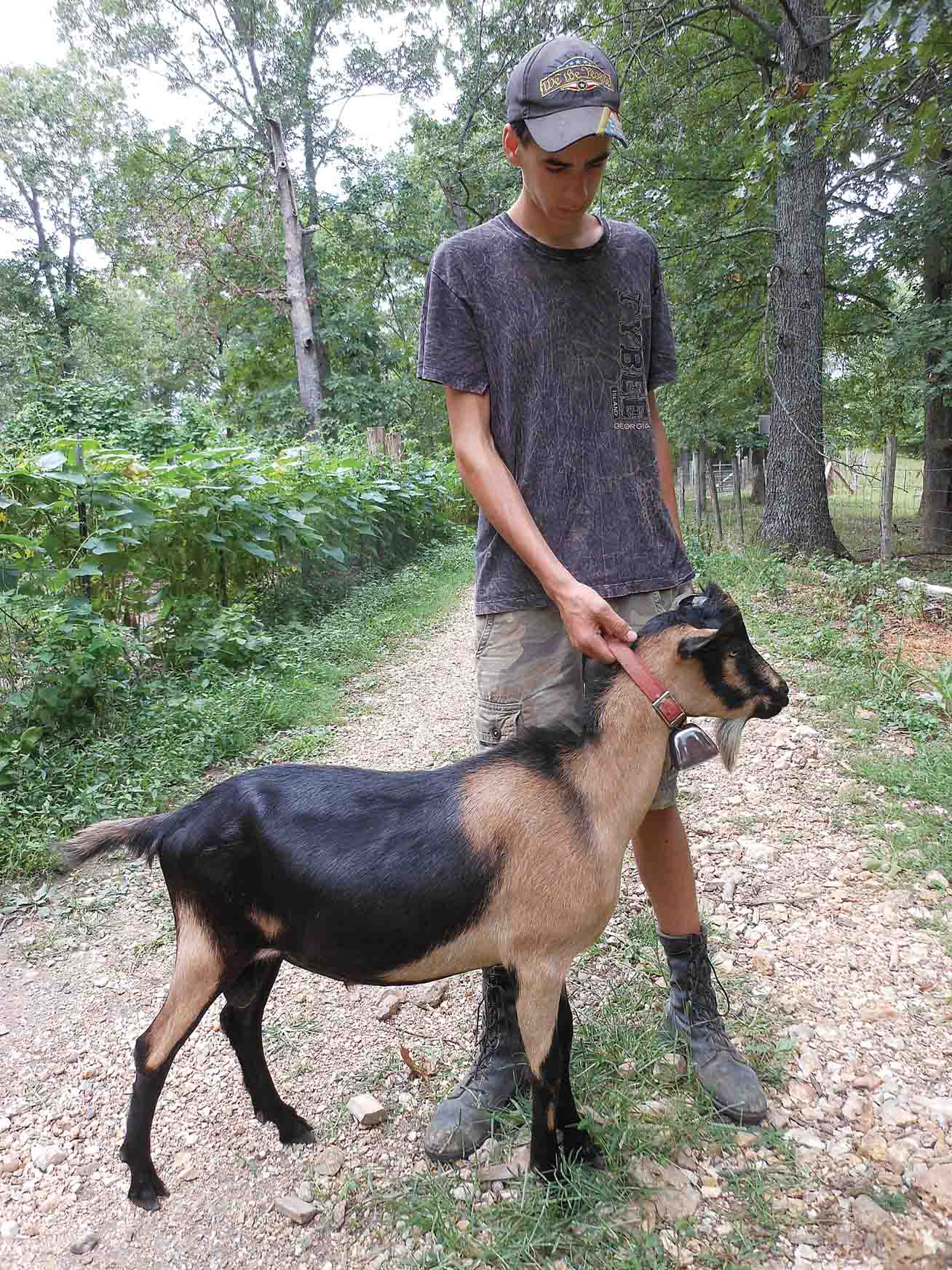
Control a buck by keeping his head up when leading him. To slow him down, apply the ‘brake’ by raising his snout up.
His new home
A mature buck may be quartered in a secure buck pen immediately upon arrival at his new home. Some choice hay and a little grain will help him to settle in and accept his new surroundings.
A young buckling, however, will likely need so much care that it is convenient to house him close to the does. You will become his mother-substitute and will be responsible for feeding him, keeping him warm in cold weather, and protecting him from being bullied by the herd. I want him to realize he is a goat, however, so for the first few weeks, I keep the new youngster in an enclosed area where he can see the other goats but not be reached by the does. At night, I put several of the other kids of similar age in a stall with him so he can make some friends. After I am satisfied that he will not be bullied or injured by the older animals, he is allowed to go out to pasture with the herd.
I feed a buckling younger than seven weeks old warm pasteurized milk (100° Fahrenheit) three times a day. After seven weeks, the number of feedings is cut to two per day to encourage him to eat more roughage. As his milk intake decreases, I also begin feeding a 14% protein dairy goat ration. When he is four months old, I wean him completely off milk. Then his grain ration is gradually increased until he is eating four cups of grain per day by his first autumn.
Housing
Young bucks are capable of breeding at the age of four months or even younger, so to prevent unplanned early mating, a secure buck pen with sturdy fences is needed. The pen can be constructed of cattle panels or 48-inch field fencing with a strand of barbed wire one foot above that. Just make sure it is tight and the corners are well braced. Unruly males can be reminded to respect the fence by adding a hot electric wire. The gate should be equally as sturdy with strong hinges and a latch that he can’t open. Consider placing water tanks and hay racks close to the fence so they can be cleaned and filled without entering the pen. You will appreciate not having close contact with him as breeding season approaches and his aggression level rises.
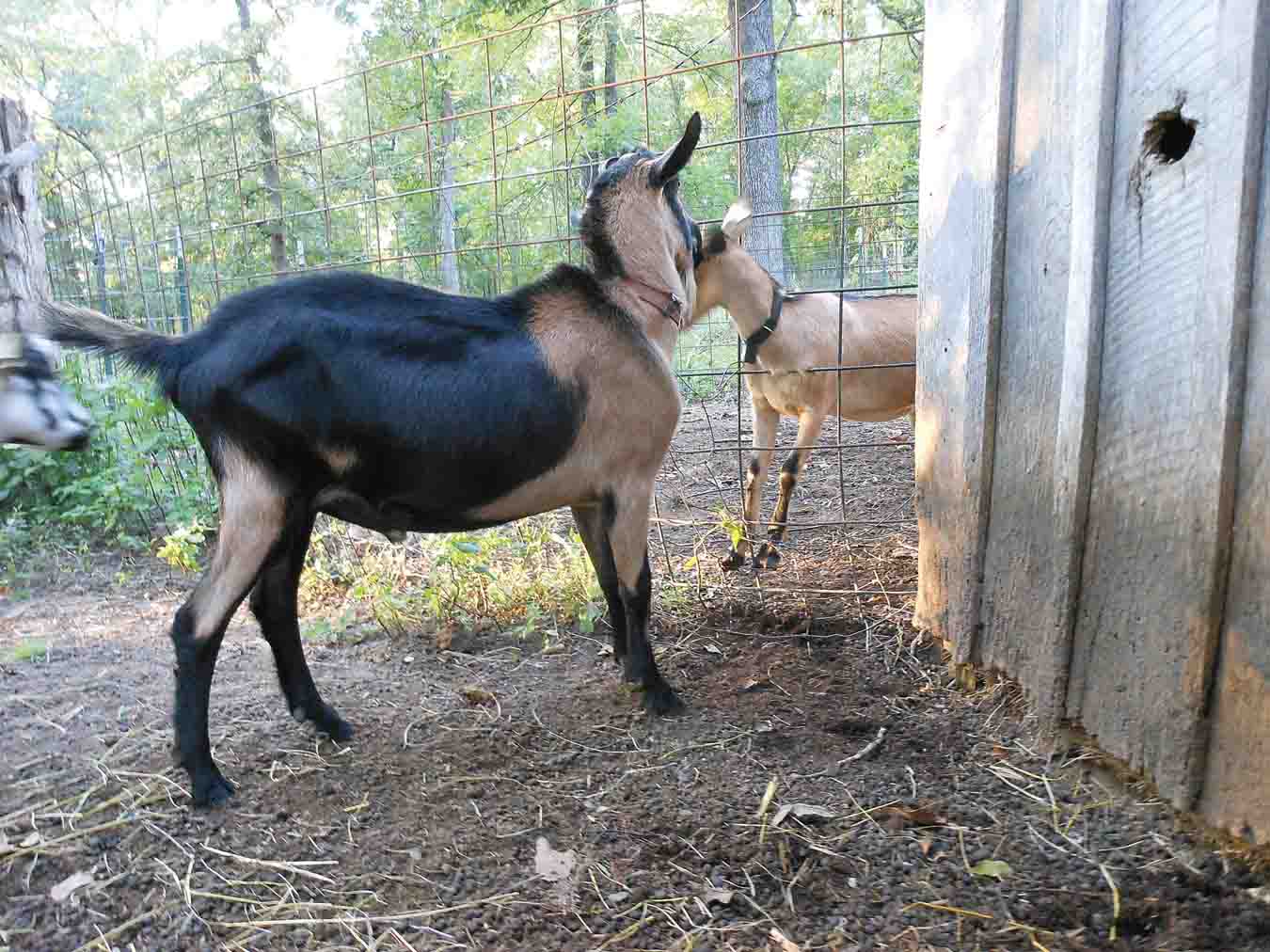
A six-month-old doe entering estrus and flirting with the buck. Given time, they will figure out how to mate through the fence.
Your buck will be healthier if he gets plenty of exercise. The pen should be large enough for him to walk around and trot a bit. It’s a good idea to provide him with “toys” like a tire swing to butt, so that he burns off excess energy appropriately. Butting and sparring are a buck’s favorite games, and he will spend many happy hours sending his tire swing sailing high into the air. Some keepers provide their buck with a whether (castrated male) to keep them company, but this is not absolutely necessary.
Goats loathe getting wet, so he will need shelter from rain and snow. It need not be elaborate. The shelter in my buck pen is a simple lean-to with open sides attached to the outside of the goat barn. With a pile of old hay for bedding, it makes a comfortable spot for him to sleep and lounge. During periods of wind-driven rain or heavy snow, I let him into the barn to ride out the storm with the does. He is also allowed into the barn to sleep when the night time temperature drops into the teens.
Make sure your buck has shade in the summer so he doesn’t overheat. Of course, a tree growing in the buck pen is the best shade, and a great place to hang that tire swing. A goat will not usually strip the bark from a large hardwood tree. But if in doubt, wrap several layers of chicken wire or old rugs around the trunk to protect it from damage.
Give some thought to the location of the buck pen. A pen that doesn’t share a fence line with the does will help prevent unwanted mating during breeding season. But it should have easy access and be close enough to the rest of the herd to make it convenient for chores. There is no way to put this delicately — bucks stink. They always smell a little musky, but during breeding season they intentionally urinate on themselves and develop an odor that only a doe in the throes of estrus will appreciate. Some goat owners (and their neighbors) find this offensive and want to locate the buck pen far away. There is also a belief that a buck’s smell will taint the does’ milk if he is housed near the does. However, I believe it is a mistake to house a buck far away from the other animals. He depends on me to keep him healthy and safe, and it is too easy to ignore him if it isn’t convenient to tend him. My does’ milk has never been contaminated due to the buck’s proximity, either. I accept his smell as one more facet of country life, and although my buck smells very badly in the fall, he always smells better than hogs.
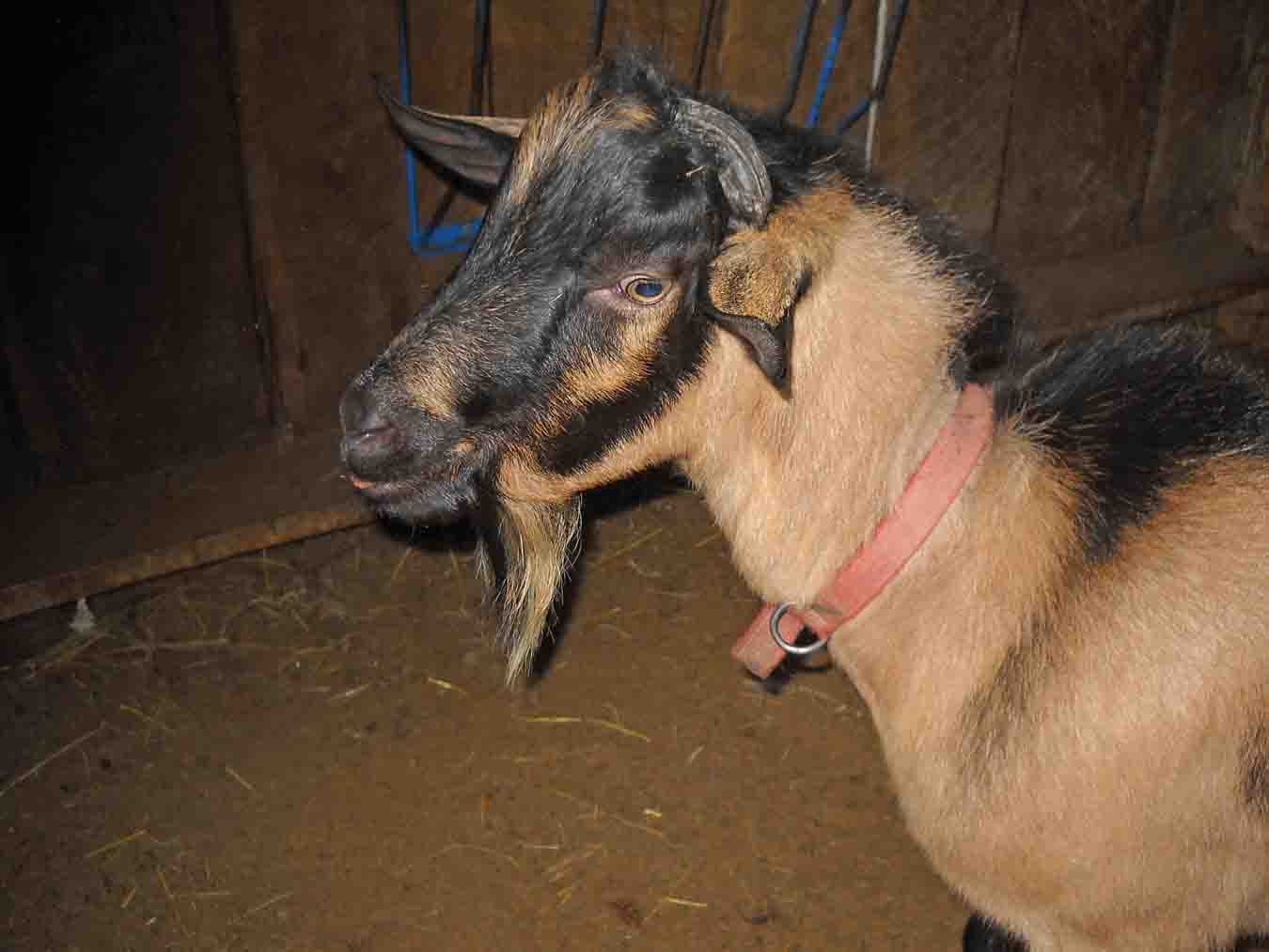
In the fall it is normal for a buck to spend a lot of time with his tongue out when he is among the does.
Forage
Bucks need high quality forage to maintain their body weight. A mixed grass and legume pasture will allow bucks to gain weight and go into breeding season in good condition. I allow my buck to go out to pasture with the herd each day during the spring and summer. When they come back to the barn in the evening, I put the buck back into the buck pen and feed him his grain ration. He goes into his pen without fuss and this daily handling helps keep him tame and co-operative. Goats are browsers, so I let my entire herd into my wood lot in mid-summer for two or three weeks to graze down the underbrush. This benefits the goats by providing nutrients they wouldn’t normally get, and reduces the fire danger by thinning the underbrush and low hanging limbs.
Good quality hay will keep a buck in good condition throughout the winter. A grass and legume mixed hay is ideal, and generally not too expensive. Throughout the winter, I feed him hay twice a day, and monitor his weight to make sure he is getting enough.
The grain ration
A mature dairy goat buck of a standard breed can weigh 175 pounds or more, and needs a lot of nutrients to maintain the energy level required of him during breeding season. Feeding a high quality grain ration is an important component of keeping my herd sire healthy. During the winter, I feed my mature buck a maintenance ration of two cups per day of 14% protein dairy feed. This amount is discontinued when he is turned out on pasture in the spring. Then the first day of August, I start gradually feeding him grain again, until he receives four cups a day by the end of the month. He receives this amount every day for several months, until he has bred all of the does in the herd.
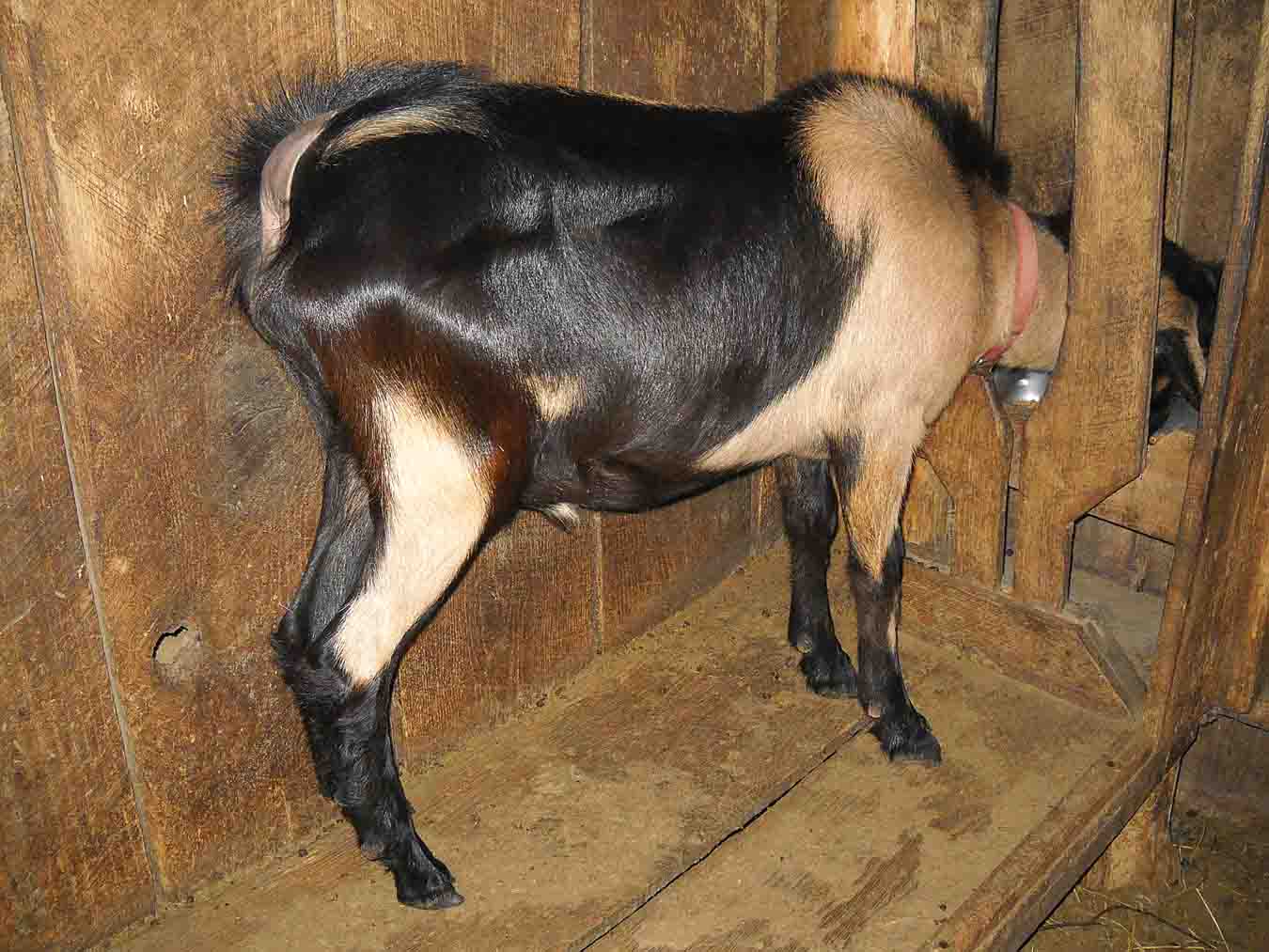
Placing him in a stanchion makes it easier to do chores like hoof trimming.
Socialization and handling
Animals that trust and like people are much easier to handle throughout the year and tend to be less dangerous during breeding season. So I give my buck some attention throughout the year to keep him tame. I occasionally give him an apple or sweet potato and pet him so he will associate humans with good things.
Misbehavior toward humans should be dealt with immediately with gentle correction. Bucks, even young ones, will place their front feet on top of other goats or attempt to mount as a sign of dominance. So never allow a buck to place his front hooves on a person. Push him down by placing your palm on his cheekbone or the point of his shoulder and press backwards or sideways until he loses his balance and falls off. Alternately, you can raise your knee and bump him in the chest. A buck will also sometimes approach and stand with his head pressed against a person’s body. It has been my experience that this is not a request to be pet, but instead a signal that he wants to spar. I don’t tolerate this, either, but push him gently away.
A standard breed mature buck can be as strong as a small pony, but control his head and the rest of him will follow. My buck wears a collar so he is easier to control, and I train him to lead while he is young and easy to handle. Keep the collar right behind his ears to keep his head up while leading him, because he can drag you where he wants to go if he gets his head down. He can also be slowed down by placing your free hand under his chin and lifting his snout above the level of his eyes.
A reluctant animal, or one that is crowding you, can be turned in a different direction similar to the way a handler can move a horse. Press against the point of his shoulder until he shifts his weight to the opposite front leg. Then push his head in that direction with your palm on his cheek, or lead him in that direction with his collar. A buck that refuses to go in the direction you wish can often be moved with this maneuver by turning him a complete 360 degrees and then leading him off. Remove any pressure against his body as soon as he complies or he may think you are inviting him to play a butting game.
Never allow anyone to roughhouse with a buck of any age. Teenage boys and sometimes even grown men think it’s fun to practice wrestling holds on a buck. This will turn him into an extremely aggressive animal — he will view humans as something to challenge and possibly attack. For the same reason, it is usually a mistake to strike a buck, no matter how obnoxiously he acts. He instinctively views this as a territorial challenge and will be quite willing to react in kind. With his body mass and strong thick skull, he will win. Be especially vigilant when friends are visiting. Your own children may know not to enter the buck pen, but non-farm raised children often think that goats can be ridden like horses.
It can be dangerous to be in any small enclosed area with a buck. This includes stalls, alley ways of barns, or leading one through a gate. He can suddenly swing his hind quarters away from you, and then use his head and body weight to shove you into the wall or a fence post. The risk increases as breeding season approaches. During this time, I try not to directly handle my buck at all to reduce the risk of injury to myself. I simply open the buck pen gate and let him join the does in the morning. At night when the gate is opened for him, he usually goes back in his pen willingly to eat his grain.
Bucks will sometimes attack without warning, but they often signal their intention first. He may approach broadside to display his size, with his neck arched and his head low. The hair along his spine may stand up. He may walk with a prancing gait and toss his head back and forth right before he charges or rears onto his hind legs to gain momentum. Don’t be afraid of your buck, but don’t trust him either. When handling him your demeanor should be calm, firm, and cautious. Always be ready to take evasive action if his behavior becomes belligerent.
Breeding season
As the shorter days of autumn usher in breeding season, your buck may begin to test the strength of his enclosure. Make sure that fences are tight with no low spots. If you use electric fencing, make sure the charger is on and operating properly, and that nothing is grounding out the fence. His neck will begin to swell as the season progresses, so loosen his collar several notches so that he doesn’t choke.
He will also experience a dramatic personality change. The mating instinct over-rides everything, including respect for humans. He may be sweet and affectionate the rest of the year, but as the does enter estrus, his testosterone level will cause him to view everything that moves as a rival. He will fight the water tank, hay rack, chickens, or anything else that has the misfortune to be in the buck pen with him.
I prefer newborn goats in March, so I intentionally delay mating by removing the buck from the herd August 1st. My does start cycling into heat in early-September, so this first heat cycle is missed. Then, the buck rejoins the herd on October 1st for the doe’s next heat cycle. This usually gives me kids in early March when the weather is warmer.
If your buck is continuously pastured with your herd, however, he will detect estrus and breed your does with no input from you. A healthy buck in his prime radiates virility and goes about the task with great enthusiasm. The first time I witnessed the event, I suddenly understood why male goats were symbols of fertility gods in ancient times. He will stand with neck outstretched and upper lip curled up (called “the flehmen position”) as he checks the breeze for the scent of a doe in heat. He will communicate with her with a characteristic snort followed by a series of throaty grunts. He may paw at her, lick her on the neck or forequarters, or drink her urine. She will run from him until she is receptive, at which point she will stand for him and mating will take place. Although the first mating usually results in pregnancy, the couple may continue these activities for hours, with copulation occurring many times. Anytime my buck refuses to leave a doe, I let them be. He knows when his job is done for the day, and I respect his opinion.
Health issues
Well cared for bucks are usually healthy, but issues do occur. The following problems are the most common.
Scurs:
Bucks that have been dehorned will probably still grow scurs, misshapen horn-like growths that lack an interior bone and are not firmly attached to the skull. They can be identified from true horns by tugging on them. Scurs will move, or wiggle slightly, while true horns are immobile. They can grow quite large, and sometimes curl downward toward his neck or eyes. It’s a good idea to provide a buck with “toys” like a tire swing or something else he can butt, so he will knock scurs off before they grow very large. A light dusting of blood stop powder can be used to control the resultant bleeding.
Urinary calculi:
Urinary calculi, or urinary “stones,” are a serious disorder of the urinary tract in male goats. Deposits of phosphate salt form in the urine when goats are fed a diet high in phosphorus or magnesium, but low in calcium. These deposits (calculi) can then lodge in the urethra where they stop the flow of urine. Symptoms include pain, swelling around the penis, and the goat standing with a hunched back as he strains to urinate. If recognized early, a veterinarian can perform surgery and possibly save the animal. Left untreated, death occurs from a burst bladder.
Urinary stones can be prevented through proper diet. The primary cause of calculi formation is a diet rich in grain products and low in forage. Therefore, limit the amount of grain your buck eats, especially if grains high in phosphorus like corn or wheat are the primary ingredients. Check feed labels for a calcium to phosphorus ratio of at least 2:1. Access to a mineral supplement with at least a 2:1 calcium to phosphorus ratio is also beneficial. But the easiest way to prevent urinary calculi is to provide your buck with plenty of quality forage high in calcium, such as clover, alfalfa, or mixed grass/ legume hay. Clean, fresh water should also always be available because dehydration causes urine to become concentrated and more prone to develop calculi.
Parasites:
Goats are subject to internal parasites that rob their host of nutrition and vitality. The animal loses weight, has a scruffy hair coat, stops eating, and often develops anemia or diarrhea. Left untreated, severe infestations of certain parasites lead to death. Your vet can examine a fecal sample to diagnose and suggest treatment anytime parasites are suspected. Rotational grazing, where animals are removed from fields for extended times and then placed on “clean” pasture can help limit the numbers of worms your animals are carrying.
Routine care
Bucks also need some routine care. Trim his hooves every few months so they don’t become overgrown. Hooves are softer and easier to trim after a rain when the herd has been out on damp pasture. It’s best to lock his head into a stanchion for this procedure, and reward him with grain for cooperating. It is also a good idea to trim his hair when warm weather arrives. This reduces his odor, helps him stay cooler, and allows a better view of his body to check for injuries.
It is important to monitor your buck’s weight, eating habits, and overall health. For most of the year, the most important thing in his life should be food. He should steadily gain weight through the spring and summer until he is pleasantly plump. Once breeding season begins in September he will run that fat off in a surprisingly short time. A buck covering a large herd of does can lose so much weight during breeding season that he goes into winter with little body fat. Then, if the winter is long or hard, he may find it difficult to recover. For these reasons, I like to see my herd sire carrying a little excess weight in late summer. Any time my buck loses his appetite for more than 24 hours, I begin to worry.
Final thoughts
The production of a dairy herd can deteriorate within a generation if a mediocre buck is used and the resulting offspring kept as replacement milkers. So consider the acquisition of good breeding stock as an investment. If money is tight, spend it on a high quality herd sire, and treat him well so he provides years of service.

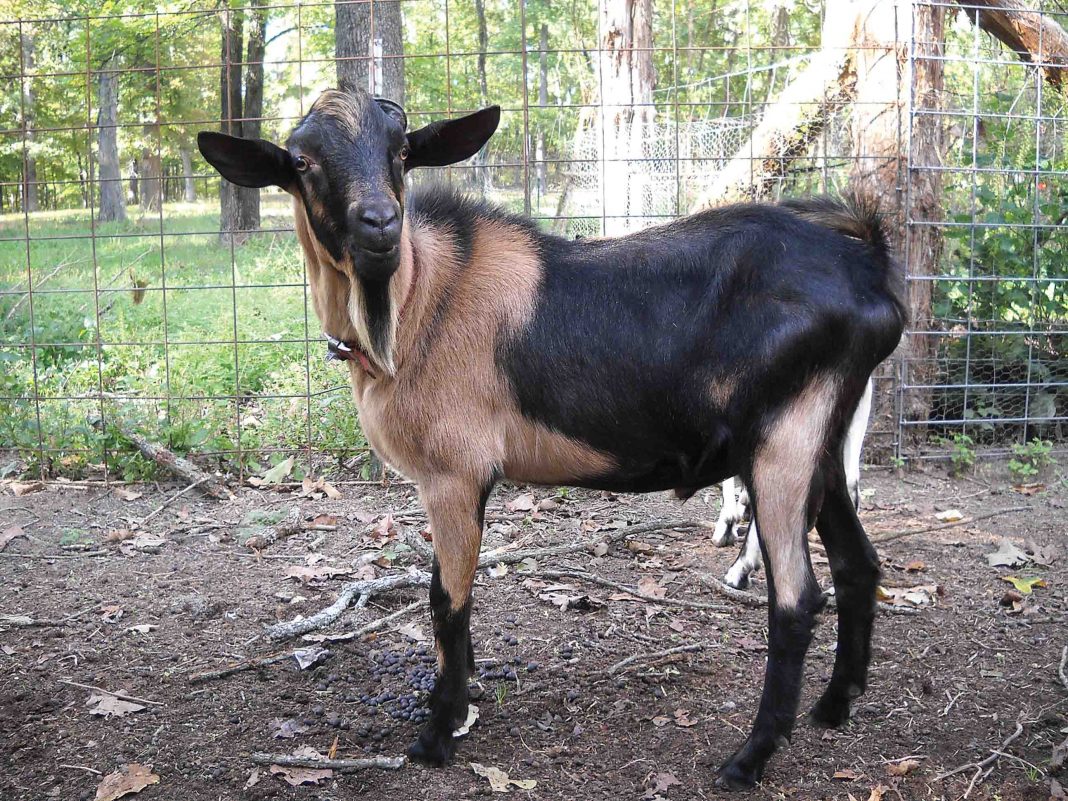
I was told that feeding my buck dairy grain would hurt his organs. Can you tell me what grain you feed yours here for reference, please?
Thanks!
great
liked the information provided. would like to get more knowledge un future
very informative. enjoyed reading it.